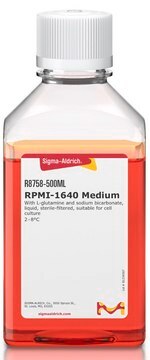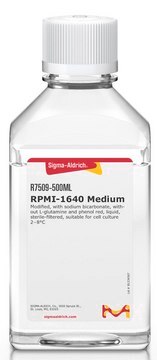R4130
RPMI-1640-Medium
HEPES Modification, with L-glutamine and 25mM HEPES, without sodium bicarbonate, powder, suitable for cell culture
Arzneimittelherstellung
About This Item
Empfohlene Produkte
Qualitätsniveau
Form
powder
Methode(n)
cell culture | mammalian: suitable
Komponenten
L-glutamine: yes
NaHCO3: no
phenol red: yes
HEPES: 25 mM
sodium pyruvate: no
Versandbedingung
ambient
Lagertemp.
2-8°C
Suchen Sie nach ähnlichen Produkten? Aufrufen Leitfaden zum Produktvergleich
Verwandte Kategorien
Allgemeine Beschreibung
Menge
Rekonstituierung
Lagerklassenschlüssel
11 - Combustible Solids
WGK
WGK 2
Flammpunkt (°F)
Not applicable
Flammpunkt (°C)
Not applicable
Analysenzertifikate (COA)
Suchen Sie nach Analysenzertifikate (COA), indem Sie die Lot-/Chargennummer des Produkts eingeben. Lot- und Chargennummern sind auf dem Produktetikett hinter den Wörtern ‘Lot’ oder ‘Batch’ (Lot oder Charge) zu finden.
Besitzen Sie dieses Produkt bereits?
In der Dokumentenbibliothek finden Sie die Dokumentation zu den Produkten, die Sie kürzlich erworben haben.
Kunden haben sich ebenfalls angesehen
Protokolle
Powdered media and salt mixtures are extremely hygroscopic and should be protected from atmospheric moisture.
Unser Team von Wissenschaftlern verfügt über Erfahrung in allen Forschungsbereichen einschließlich Life Science, Materialwissenschaften, chemischer Synthese, Chromatographie, Analytik und vielen mehr..
Setzen Sie sich mit dem technischen Dienst in Verbindung.


